
Powerpoints to help students identify and/or reveal theme in seleceted passages.
- Subject:
- English Language Arts
- Material Type:
- Activity/Lab
- Provider:
- E Reading Worksheets
- Author:
- E Reading Worksheets
- Date Added:
- 02/26/2019

Powerpoints to help students identify and/or reveal theme in seleceted passages.
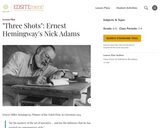
In this lesson, students study issues related to independence and notions of manliness in Ernest Hemingway’s “Three Shots” as they conduct in-depth literary character analysis, consider the significance of environment to growing up and investigate Hemingway’s Nobel Prize-winning, unique prose style. In addition, they will have the opportunity to write and revise a short story based on their own childhood experiences and together create a short story collection.

This To Kill a Mockingbird Teacher’s Guide supports standards-based instruction for middle and high school grades and is divided into three main sections. The first, "Guided Reading Questions," will help students with reading comprehension and appreciation. The second section, "Writing and Discussion Prompts," consists of analytical writing and discussion prompts. The third section, "Research Topics," requires students to conduct and synthesize significant outside research on topics related to the novel.

This teacher's guide for Totally Joe by James Howe contains discussion questions, activities, and research assignments.

In this CCSS lesson, students will explore this history through these stories with text dependent questions, academic vocabulary, and writing assignments.

In this lesson exemplar, students will participate in critical discussion of two stories that illuminate important, yet divergent, experiences of war and conflict.
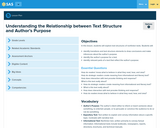
In this lesson, students will explore text structures of nonfiction texts, identify transitions and text structures to draw conclusions and make inferences about the author's purpose, and identify relevant parts of a text to reflect the author's purpose.

The Unit 2: Theme Learning Plan allows students to choose how the learn, practice, and show mastery of Standard RL.8.2 Determine a theme of a text and analyze its development over the course of the text, including its relationship to the characters, setting, and plot; provide an objective summary of the text. The data of mastery will be recorded on the Learning Plan and then placed in the student's data notebook. This resource was developed as part of a professional learning opportunity funded by the NCDPI Digital Learning Initiative Planning Grant.
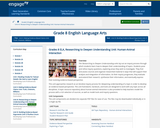
The Researching to Deepen Understanding units lay out an inquiry process through which students learn how to deepen their understanding of topics. Students pose and refine inquiry questions, exploring areas they wish to investigate. They find and assess sources and organize researched material in ways that will support their analysis and integration of information. As their inquiry progresses, they evaluate and extend their research, synthesize their information, and eventually express their evolving evidence-based perspective.
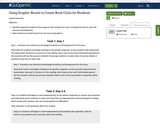
Objective: Identify supportive evidence that supports their analysis of a text, including the theme, plot and character development. Make inferences based drawn from the text and graphics.

A sixth grade boy lives with his mother. The mother maintains their livelihood with a blue collar job. In the story, William wants to find a cure for unhappiness that he sees in his mother and a man on the street. In this CCSS lesson, students will explore this story through text dependent questions, academic vocabulary, and writing assignments.

In this three week unit on the novel The Pearl, by John Steinbeck, students examine and discuss the characteristics of a novel, compare and contrast the novel to folk tales and short stories, write chapter summaries and essays, and conduct Internet research to prepare slideshow presentations on related topics including those reflecting cultural differences of the novel's characters and those issues involving the economic principle of supply and demand.

The narrator of The White Umbrella is a Chinese American girl who struggles with feelings of embarrassment and longing to be like others. In this CCSS lesson, students will explore this story through text dependent questions, academic vocabulary, and writing assignments.

Brian Aldiss describes a futuristic world in which machines are capable of thinking based on the tasks they have been designed to perform. One day the machines realize that the few remaining humans have died, leaving the machines to fend for themselves. In this CCSS lesson, students will explore this story with text dependent questions, academic vocabulary, and writing assignments.

The wind and water are personified as two women talking about their children. Mrs. Wind brags about her children, which annoys Mrs. Water who drowns Mrs. Wind’s children when they come to her for a drink. As Mrs. Wind calls for her children, white feathers come to the top of the water, causing whitecaps. In this CCSS lesson, students will explore this story through text dependent questions, academic vocabulary, and writing assignments.
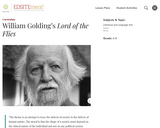
William Golding's Lord of the Flies is a novel that engages middle school students in thought-provoking discussion, and provides practice in literary analysis skills. The three lessons in this unit all stress textual evidence to support observations and generalizations uncovering the novel's central character traits, symbols and themes.

This resource contains worksheets, projects, and activities for William Golding's Lord of the Flies.
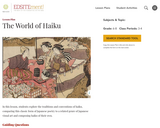
Explore the traditions and conventions of haiku and compare this classic form of Japanese poetry to a related genre of Japanese visual art.

“The Wreck of the Hesperus†is a narrative poem about an arrogant ship captain (skipper) who takes his daughter on an ill-fated voyage across a wintry sea. In this CCSS lesson, students will explore this poem through text dependent questions, academic vocabulary, and writing assignments.

This lesson invites students to reconfigure Meg’s journey into a board game where, as in the novel itself, Meg’s progress is either thwarted or advanced by aspects of her emotional responses to situations, her changing sense of self, and her physical and intellectual experiences.